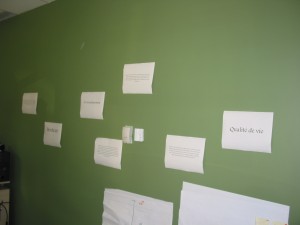If you are looking for an activity to increase team synergy in an attempt to develop a high performance team, what choices come to mind? A rally? An adventure race? A week-end away? A parachute jump?
Unless you are my wife, the thought of using a budgeting exercise to build team synergy seems ludicrous, especially when the team is mostly composed of senior software engineers and marketing people!
I knew that for most people, the thought of sitting for two full-days of budget planning would be more terrifying than a visit to their dentist for a root canal. Without fear or hesitation and listening only to my courage, I decided to leverage this important corporate exercise (aka. The Budget) with the goal to create a highly performing cross-functional team.
In line with a post recently published by Mike, I followed very simple guidelines to maximise the impact of the exercise.
Invite people to the exercise
In his book (The Right Use of Power), Peter Block suggests that proceeding by invitations when asking people to participate in an exercise or a meeting is much more powerful than deciding yourself who should (or shouldn’t) be part of the group. Since the cross-functional team I was working with needed to represent each area of the organization and I only wanted one representative from each unit, I asked for volunteers. In traditional organizations, the participants would have been selected based on specific criteria. Instead, I opted to ask for volunteers. This had the dual benefits of increasing active participation during the meeting and helping people buy-in to the results once the exercice was over.
Establish roles and responsibilities
To build a self-organized team, I wanted people to determine what each of the participants contributed to the overall discusion. Coming in to the meeting, each participant knew their role was to represent their community. As such, they needed the authority to make decisions on behalf of their group and have a good understanding of the business assumptions so as to know what could (and couldn’t) be changed in their budget. What is typically called empowerment totally applied in this case.
Establish clear objectives
The group was informed ahead of time of the objective they were to reach “x% operating income for the coming year”. All other variables were left to the group to decide. How each group would reach their own objective and how that fit into a global perspective and their strategy was left entirely to them.
Establish an agenda and ground rules
The agenda for the exercise was clearly established ahead of time in order to support the group in reaching their objectives. In addition to the agenda for the two days meeting, ground rules were established.
(translated from French)
Ground rules
- Active participation in the discussions
- Pay attention to what others are saying
- Be open to constructive feedback (it is not personal)
- You can enter and leave the room only when the door is open
- Be on time
- Accept to step outside your comfort zone
- Express yourself (kindly) when you are upset
- Have a bit of fun (it is already included in the budget)
I have seen too many sessions being facilitated without any ground rules or a clear agenda which typically leads to bad meetings. Wanting to avoid wasting a great opportunity to build team synergy, I made sure those two items were well taken care of.
Get a skilled facilitator
I took charge of facilitating the meeting. I have a few skills and facilitating meetings is one of them
Conclusion
After two very intense days of work, the cross-functional team was able to reach an agreed upon target. Coming in to the meeting, nobody believed we could establish challenging targets for ourselves and most importantly, no one thought they would take full ownership of the end results once the exercise was over.
Once again, in traditional organizations where budgets are a top-down activity imposed by the CEO down the chain of command, ownership of each unit’s budget is un-heard of. In our case, people agreed that the exercise had High Value with a perfect 5 / 5 (see Utilité below), Return on Time Invested of 4.1 / 5 (see ROTI below), and a fun factor of 3.3 / 5 (see Fun below).
Not bad for an exercise that was originally compared to a visit to the dentist !







Recent Comments